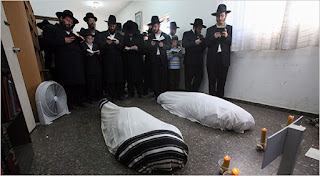Death rituals in brief:
At death, a Jewish person's body is cared for by the chevra kiddisha, the "holy society," who wash the body and prepare it for burial. The deceased is treated with great respect and never left alone. After burial, the deceased's loved ones enter a formal period of mourning, which decreased gradually over the course of a year. The dead is then remembered and honored each year on the anniversary of death.
-Treatment of the Body:1- Caring for the dead
Most Jewish communities have a special group of volunteers, the "holy society" (chevra kaddisha) whose job is to care for the dead. This work holds great merit since those they serve can never repay them. They are responsible for washing the body and preparing for burial in accordance with Jewish custom.
2- Caskets and coffins
After the burial, a relative or friend prepares the "meal of condolence," which traditionally consists of eggs (symbolizing life) and bread. This meal is for family only, but visitors may come to offer condolences afterwards.
Dead bodies may not be cremated, and burial takes place as soon as possible after death. Embalming and the removal of organs and fluids is prohibited, although there are allowances for autopsies and organ donation. The former can be done if it would save a life or if local law requires it; the latter may be done since the organ's eventual burial will fulfill the requirement to bury the entire body.
2- Caskets and coffins
Open caskets are forbidden by Jewish law, as it would be disrespectful to allow any enemies of the dead to view them in their helpless state. Bodies are buried in a simple linen shroud, so that the poor will not receive less honor than the rich. The body is also wrapped in a tallit.
Coffins are not required, and are not used in Israel. If they are used, holes must be drilled into them to allow contact with the earth. A handful of earth from Israel is thrown in the casket with the body by a family member. These practices are intended to put the body in the closest contact with the earth as possible, and reflect the belief that the dead will rise in Israel in the age of the messiah.
- Tombstones
Jewish law requires that tombstones be erected on all graves, so the dead will be remembered and the grave will not be desecrated. In some communities it is customary to place stones on the grave when visiting, as was done in the film Schindler's List. The origins of this tradition are not entirely clear, and it is not universally practiced.
Jewish tombstones display the sort of information found on most tombstones: the name of the deceased, date of death, and a short benediction. This information is normally written in Hebrew, and certain symbols indicating the deceased is Jewish may also be present, such as a menorah, star of David, torah scroll, lion, or the tablets of the Ten Commandments.
- After the burialAfter the burial, a relative or friend prepares the "meal of condolence," which traditionally consists of eggs (symbolizing life) and bread. This meal is for family only, but visitors may come to offer condolences afterwards.
The family then enters a seven-day period of intense mourning (shiva, "seven"). Mourners sit on low stools or the floor instead of chairs, do not wear leather shoes, shave or cut their hair, wear cosmetics, work, bathe, have sex, put on fresh clothing, or study Torah (except Torah related to mourning and grief).
They wear the clothes they tore when they learned of the death or at the funeral. Mirrors in the house are covered. Prayer services are held where the shiva is held, with friends, neighbors and relatives making up the minyan. Shiva is followed by schloshim ("thirty"), which lasts until the 30th day after burial. During this period, the bereaved do not attend parties or celebrations, do not shave or cut their hair, and do not listen to music.
- One-year mourning
The final period of formal mourning, avelut, lasts for 12 months from burial and is observed only for a parent. During avelut, mourners do not go to parties, the theater or concerts. The son of the deceased recites the Kaddish prayer every day for 11 months. (Why not 12? Traditionally, the soul must purify itself before going to the world to come, which takes up to 12 months for the most evil. To recite the Kaddish for 12 months could imply the parent was the type that would need that long, so rabbinical authority set the limit at 11 months.)
Interestingly, the mourner's Kaddish does not mention death. Rather, it praises God and asks for the establishment of God's kingdom. Its purpose is to reaffirm the faith of one who has lost a parent, a time when one is especially vulnerable to turning away from God. This in turn honors the deceased, since it demonstrates he or she has raised a child with faith that is strong enough to endure the death of a loved one.
After the first year, the anniversary of death (yahrzeit) is remembered annually at the synagogue. The son recites the Mourner's Kaddish and makes the aliyah, and a candle is lit that burns for 24 hours.
Interestingly, the mourner's Kaddish does not mention death. Rather, it praises God and asks for the establishment of God's kingdom. Its purpose is to reaffirm the faith of one who has lost a parent, a time when one is especially vulnerable to turning away from God. This in turn honors the deceased, since it demonstrates he or she has raised a child with faith that is strong enough to endure the death of a loved one.
After the first year, the anniversary of death (yahrzeit) is remembered annually at the synagogue. The son recites the Mourner's Kaddish and makes the aliyah, and a candle is lit that burns for 24 hours.






No comments:
Post a Comment